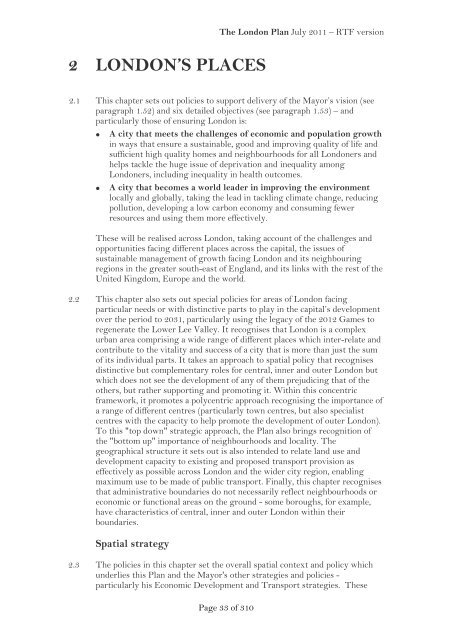London Plan 2011 PDF 1 MB - Lambeth Council
London Plan 2011 PDF 1 MB - Lambeth Council
London Plan 2011 PDF 1 MB - Lambeth Council
Create successful ePaper yourself
Turn your PDF publications into a flip-book with our unique Google optimized e-Paper software.
2 LONDON’S PLACES<br />
The <strong>London</strong> <strong>Plan</strong> July <strong>2011</strong> – RTF version<br />
2.1 This chapter sets out policies to support delivery of the Mayor’s vision (see<br />
paragraph 1.52) and six detailed objectives (see paragraph 1.53) – and<br />
particularly those of ensuring <strong>London</strong> is:<br />
• A city that meets the challenges of economic and population growth<br />
in ways that ensure a sustainable, good and improving quality of life and<br />
sufficient high quality homes and neighbourhoods for all <strong>London</strong>ers and<br />
helps tackle the huge issue of deprivation and inequality among<br />
<strong>London</strong>ers, including inequality in health outcomes.<br />
• A city that becomes a world leader in improving the environment<br />
locally and globally, taking the lead in tackling climate change, reducing<br />
pollution, developing a low carbon economy and consuming fewer<br />
resources and using them more effectively.<br />
These will be realised across <strong>London</strong>, taking account of the challenges and<br />
opportunities facing different places across the capital, the issues of<br />
sustainable management of growth facing <strong>London</strong> and its neighbouring<br />
regions in the greater south-east of England, and its links with the rest of the<br />
United Kingdom, Europe and the world.<br />
2.2 This chapter also sets out special policies for areas of <strong>London</strong> facing<br />
particular needs or with distinctive parts to play in the capital’s development<br />
over the period to 2031, particularly using the legacy of the 2012 Games to<br />
regenerate the Lower Lee Valley. It recognises that <strong>London</strong> is a complex<br />
urban area comprising a wide range of different places which inter-relate and<br />
contribute to the vitality and success of a city that is more than just the sum<br />
of its individual parts. It takes an approach to spatial policy that recognises<br />
distinctive but complementary roles for central, inner and outer <strong>London</strong> but<br />
which does not see the development of any of them prejudicing that of the<br />
others, but rather supporting and promoting it. Within this concentric<br />
framework, it promotes a polycentric approach recognising the importance of<br />
a range of different centres (particularly town centres, but also specialist<br />
centres with the capacity to help promote the development of outer <strong>London</strong>).<br />
To this "top down" strategic approach, the <strong>Plan</strong> also brings recognition of<br />
the "bottom up" importance of neighbourhoods and locality. The<br />
geographical structure it sets out is also intended to relate land use and<br />
development capacity to existing and proposed transport provision as<br />
effectively as possible across <strong>London</strong> and the wider city region, enabling<br />
maximum use to be made of public transport. Finally, this chapter recognises<br />
that administrative boundaries do not necessarily reflect neighbourhoods or<br />
economic or functional areas on the ground - some boroughs, for example,<br />
have characteristics of central, inner and outer <strong>London</strong> within their<br />
boundaries.<br />
Spatial strategy<br />
2.3 The policies in this chapter set the overall spatial context and policy which<br />
underlies this <strong>Plan</strong> and the Mayor's other strategies and policies -<br />
particularly his Economic Development and Transport strategies. These<br />
Page 33 of 310
















